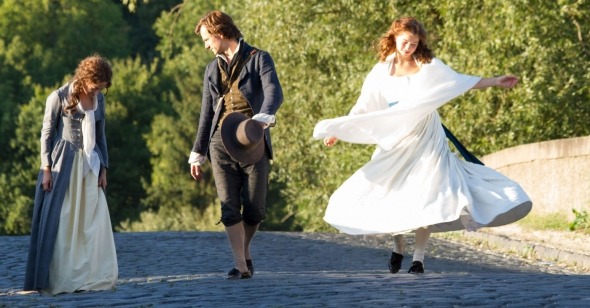Love Letters
By Chris Wisniewski
Beloved Sisters
Dir. Dominik Graf, Germany, Music Box Films
If excess—visual and aural—is the melodrama’s stock-in-trade, Dominik Graf’s Beloved Sisters is an atypical example of the genre for the extent to which it is propelled by language. A literary love triangle featuring two ferociously devoted sisters and their writerly beau, Friedrich Schiller, Graf’s film evokes a historical period where words had primacy and news, ideas, and pledges of romantic love were traded in prose and poetry. It opens on the eve of the French Revolution in the autumn of 1787 and spans more than a decade in the lives of its three principals, following them through the turn of the nineteenth century, telling a story driven less by the lust or passion that poet and philosopher Schiller (Florian Stetter) feels toward either of the titular sisters than by the currents of culture and history that shape their tumultuous lives.
The film opens on young, single Charlotte von Legenfeld (Henriette Confurius) en route to Weimar in the hopes that she can land a financially beneficial marriage that will secure a stable future for herself and her widowed mother. Her sister Caroline (Hannah Herzsprung), meanwhile, endures a loveless but practical marriage of her own, undertaken with reluctance and only after she and Charlotte, in a flashback Graf returns to repeatedly, pledge complete devotion and honesty to one another under a roaring waterfall. That primal waterfall scene seems to portend some sort of overheated sisterly drama, just as the opening close-ups of Charlotte in her carriage hint at a coming-of-age women’s picture. Superficially, Beloved Sisters fits the bill. When Charlotte and Schiller meet cute, the latter having lost his way outside her window, the movie’s basic contours come into view: take two beautiful, penniless sisters, add a handsome and brilliant young poet, and watch the sparks fly.
Such a narrative could hardly sustain Beloved Sisters for the entirety of its three-hour running time, and in fact, Charlotte’s first encounter with Schiller may be especially deft in signposting not only the movie’s obvious forthcoming plot developments but also its thematic and intellectual underpinnings. As Schiller beseeches Charlotte to help him find his way, he sketches a map in the dirt that he and she use as a directional tool. Their exchange—a clever back and forth that turns less on where Schiller is trying to go than on determining where he is—establishes Graf’s overriding interest in communication: accomplished through words and symbols, communication as relational.
Shortly after this early scene, Schiller comes to visit Charlotte at Caroline’s home. While there, he mounts a daring rescue of a drowning child. The two sisters drag him from the water before Schiller himself succumbs to the current, nearly drowning himself. Having rescued him, Charlotte and Caroline try to warm the shivering man, stripping his clothes and surrounding his naked body, doing who knows what with their arms behind their backs, their backs facing the nude Schiller. In a climactic moment when the smoldering sexual tension between the young women and the writer appears to reach a fever pitch, Graf cuts to an extreme long shot, almost willingly draining the moment of its intensity. The real drama comes after, when the three begin exchanging love notes written in a secret code, with each member of the love triangle assigned a symbol in place of a name. The movie dwells on these and other similar moments of written communication, sometimes dramatized with voiceover, sometimes with the characters directly addressing the camera. Throughout, Graf demonstrates more interest in how to visualize minds grasping at connections across distances than in the sexual or romantic energy generated by spry, beautiful bodies in close physical proximity.
This is not to say that Graf’s film is icy or academic, fully absent carnal pleasure, or that it lacks for melodramatic excess. On the contrary, the filmmaking in Beloved Sisters is restless and aggressive, with floating title cards, a pervasive voiceover, and copious pans and tilts, dollies and zooms. Graf’s movie feels most delightfully odd, though, in sequences that function as interludes—like when Schiller takes Caroline to see an innovative printing press, or when Graf dramatizes the dawn of the Reign of Terror with close-ups of blood spilling from guillotines, or when Caroline publishes a serialized novel and we see readers relishing its installments like eager television viewers eager for the next episode of their favorite show. The bravado of these digressions reveals Graf’s ambition while exposing the relative thinness of his movie’s central plot: Charlotte and Caroline’s sisterly love and its inevitable undoing, thanks to the corrosive influence of Schiller’s affection for both women, are not sufficient anchors for a 170-minute opus.
Late in the film, Schiller takes a teaching position at a university in Jena with Charlotte. He’s greeted in the lecture hall with a standing ovation—perhaps the first time the movie acknowledges the extent of the author’s fame. After, he and Caroline dance at a celebration, and an older woman approaches him and says, in earshot of Charlotte, that she and her husband have never seen a happier couple. Pangs of hurt flash across Charlotte’s face, but the incident, like much of the drama between the sisters, is underdramatized. Is Charlotte jealous of her sister? Disappointed in her own inadequacy? Or simply fearful that the tenuous three-way relationship she’s tried to broker with the two people she adores most seems woefully unstable? Given how quickly the film moves past the scene and Schiller’s career at Jena, the whole sequence feels, like many of the vignettes that make up this episodic period drama, incidental and almost perfunctory. It’s as though Charlotte, Caroline, and Schiller’s story is attenuated, an only intermittently sturdy frame for Graf’s energetic and fresh take on a period and milieu.
